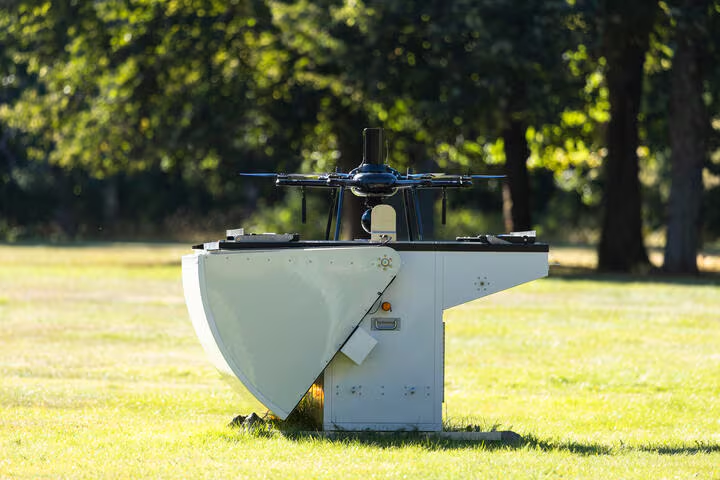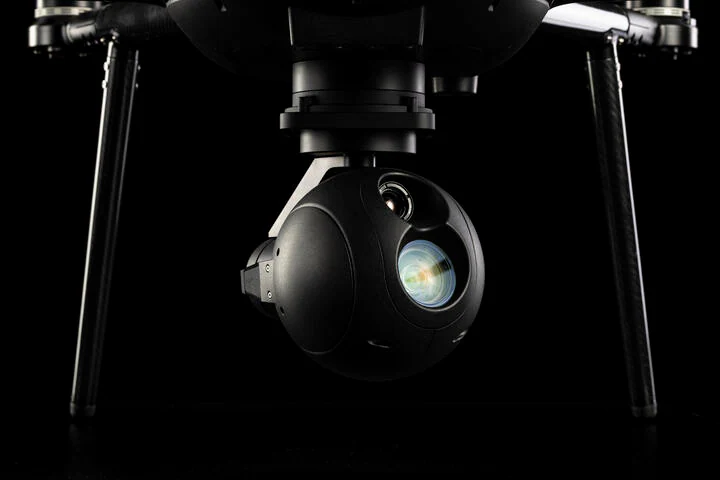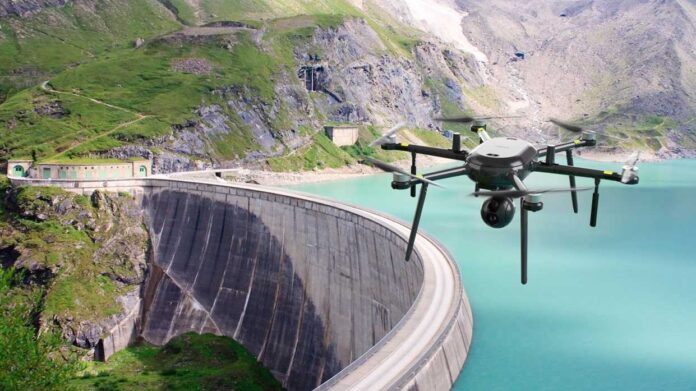As novel industrial technologies go, Nokia’s deal with Swisscom Broadcast, the Swiss operator’s enterprise-facing security and analytics arm, to deploy a network of 300 drones for emergency services and industrial applications feels significant – for both firms, as well as for the drone sector, the telecoms industry, and potentially the broader Industry 4.0 market. It hints at a model for how operators might finally create proper enterprise value out of their blue-riband assets – licensed spectrum and national infrastructure, plus trendy private-network point solutions, as required – as the foundation for a grand service proposition that actually makes a difference.
It also captures the logic, to an extent, of the new industrial 5G narrative, which Nokia has helped to articulate and commercialise over the last five years. Plus, as the biggest deal of its kind, it promises to drag the whole drone industry into serious contention in Industry 4.0 – with clearer use cases and business cases, better regulatory collaboration, a smart-looking service model, and an all-conquering new channel to market. This is the message, anyway, from Nokia and Swisscom, speaking rather excitedly last week as news dropped about the deal to sell drone-captured imagery and diagnostics about incidents, accidents, situations, circumstances – anywhere in the country.
Certainly, they sound chipper. “Yes, I’m excited – because we want to be a digitalisation partner for enterprises in Switzerland, and this is a huge step forward, which enables us to provide a huge variety of digitised services,” responds Philipp Eder, head of drones and robots at Swisscom Broadcast, to a question about just that; excitement at the ambition of the project. His namesake (not relation) at Nokia, Thomas Eder, head of embedded wireless solutions at the Finnish firm, explains the significance of public 5G infrastructure in the offer, as provided by Swisscom in Switzerland – and as provided by Citymesh in Belgium, where the template was set.
“It cannot be said often enough, but we have brilliant public 4G/5G infrastructure in Europe, like in many regions around the world; and it is unbelievable that we are not leveraging it for more. Which is the Nokia view, and why we did this in Belgium, and why we’re doing it in Switzerland now, and why we will go elsewhere next – this one-plus-one [proposition], with brilliant network services and brilliant drone technology,” he says. It says something, perhaps, that it is almost strange to hear public 5G talked about so effusively for digital-change services; the private 5G storyline, which has made secondary actors of traditional operators, has dominated the enterprise 5G narrative of late.
Just to back-track; Swisscom Broadcast is offering the drone solution as a managed service to national and regional police, fire, ambulance, and rescue services in the first instance. It uses Swisscom’s public 4G/5G network, and Nokia’s drone-in-a-box solution, sold via its new Nokia Drone Networks division. The drone bundle includes the drone, a docking station, a ground control station, a payload with video and thermal cameras, plus related software and service components. The service will scale, from a start-point of less than 100 drones (and perhaps less than 50), as customers trial the service, and multiply across different industrial sectors.

Swisscom’s Eder explains: “The roll-out plan for the next couple years is to reach 300 drones, but the initial setup is smaller.” Can you give a number for the initial deployment? Is it more like a dozen, or more like a hundred? “Somewhere between,” he responds. Nokia’s Eder chimes in: “It is just like with network planning. You assume a certain number of towers or radios to cover a certain area, but you might end up with more or less when you actually get into detailed planning. But this is only the second project of its kind, at this scale, and it will be the largest in the world. It will give the drone industry a huge push – as public networks start to be leveraged for drone operations.”
Swisscom Broadcast is offering to define and design the use cases, and to deliver the network connection and drone flight, managed by remote drone pilots in a central control room (“with full redundancy in case the main centre goes down”), plus sundry camera-based IoT telemetry data to the customer. It is also managing drone maintenance, back at base, and in the field. The solution supports third-party integrations with dispatch, management, inspection, and monitoring systems. Nokia Drone Networks is part of Nokia’s broad Mission-Critical Industrial Edge (MXIE) portfolio, but the Swisscom fleet is not being deployed with its MXIE compute platform.
Equally, the service will flex with customers and applications to also include its private 4G/5G and edge compute solutions. Swisscom’s Eder explains: “There are use cases with private networks, obviously – and we can do them, too; sometimes with the public network, and sometimes just with a private network. All of these combinations are possible. But the first phase is about the public network, and this fully-managed service – where the network, the connectivity, the drone, the flight, and the video and imagery are all delivered to the customer.” Asked about slicing, he responds: “It is the same story; a slice could be added at a later stage. But it is not part of the initial scope.”
See what I mean? The initial use case is to support nationwide emergency services, and decent public 5G infrastructure offers a good nationwide connectivity platform – whereas private 5G, useful for bespoke industrial cases, and a part of a developing proposition, is really just a point solution. Nokia’s Eder says: “Swisscom is the most capable and most developed network operator in Switzerland – which is a matter of fact, and means we can consider connectivity as a commodity, as a given. We don’t have to worry about whether the connection will be there or not. And if [the use case requires us] to infill or upsell, then that is just daily business for companies like ours.”
The point is that blue-light and public-safety services is the single segment that provides the kind of scale, potentially, to bank-roll a national fleet of drones; everything else comes after, and the drone network can be subsequently sweated on a supercharged collection of fragmented IoT use cases. He adds: “Yeah, in the future, the target is to offer industrial drones with private wireless. But the drone is just an edge node, and the connectivity is already there. In the end, whether it is public or private wireless, or something else, we don’t really care – because Nokia and Swisscom, in collaboration with the regulator, know the best technology and the best spectrum to use.”
As an aside, the point about regulation is crucial, and conquered with each deployment. Nokia’s Eder explains: “Drone regulation is not so different from spectrum regulation; there are amazing parallels. You need to obtain site permits, file paperwork. But if you are asking whether everything is sorted, so we can fly across every piece of land in Switzerland, then the answer is always going to be ‘no’. Because there are always exceptions. It is a continuous process for every site you deploy… But regulatory compliance is very familiar in telecoms, too, and both the aviation and spectrum regulators are on board. Regulation always comes first, and we are ready to roll.”
Back to use cases, and, again, the point that a drone network over the top, like a mobile network underneath, is all about scale; and a combined drone fleet for nationwide police, fire, and ambulance services is the clearest way to snowball applications into a commercial service proposition. The challenge, the story goes, is to hook the big customers and applications, and to quickly trail all the rest. “What we have learned with Citymesh, and also with Swisscom, is this is a multi-million dollar investment in the first place – which needs to be funded and approved by the stakeholders. Which is a huge undertaking,” explains Eder at Nokia.
He goes on: “[But we know] this as-a-service trend for big cap-ex investments, and we know from certain projects – for both [as-a-service] private wireless and drone networks – that the ROI can be proven in less than three years, so long as the customers and applications are there. So it requires very detailed business planning, and it requires scale. There is an analogy, perhaps, with national 4G/5G network rollout – in that it doesn’t work with a single cell tower or base station, right?” Right! And these blue-light apps – to relay footage of emergency scenarios to relevant parties before they arrive at the scene – promise a great advantage in terms of efficiencies and results.

But the myriad of industrial IoT cases in tow, which are enabled by nimble remote-controlled airborne cameras, are intriguing, too. From the outset, Swisscom’s Eder makes clear these are within its view, and important to its self-evaluation as Switzerland’s leading digital enterprise services provider – even if he backtracks later to suggest other industrial drone cases, or the private networks that might spring them, are an exercise for another day. “[We serve] all the big enterprises in Switzerland, plus also the smaller ones. And they all have tasks [where drones can help] – a lot of security jobs, for example, where there is a shortage of staff, generally,” he says.
The idea, here, is that a drone might be engaged for infrastructure inspection or perimeter protection in place of a warden with a flashlight; and also that it makes little sense to talk about private 5G, or whatever, until the use case justifies it. He goes on: “There is a place where a digital partner, like us, can offer a digital solution – where a drone, for example, can help with a lot of manual tasks. But customers expect use cases; they don’t want to buy a drone. Manufacturing companies, say, don’t know what to do with a drone. They want a full service – to solve that use case, whether it is for infrastructure inspection or perimeter protection, or whatever.”
As soon as you stop talking about technology, off the bat, you can enter into a discussion about problems and solutions, which might go anywhere, says Eder at Nokia. “We are selling the use case, not the technology. That’s what makes a difference to the customer. We are starting with the blue-light sector and public safety, like we did in Belgium. But the aim is to address any type of industrial drone use-case that pops up – because that is how an as-a-service business works, right? The rail industry is another great example; or oil and gas, or power line inspections. All of these are brilliant use cases that we will solve together at some point.”
So, just quickly, to finish up; in terms of numbers, how many drones have been deployed by Citymesh in Belgium so far? “I don’t know the exact number, but we are pretty much done with the deliveries. Citymesh is still rolling out the service. There are large events in Belgium, at the moment, where they are being used. The fire and police services across the whole of Belgium have signed up for the service, too. And there are many, many flights every day. So it’s a huge success – for everyone.” Right, and, without real numbers around the initial pace of the Swiss rollout, where is the next deal for Nokia Drone Networks? Are you going country-by-country in Europe, first?
Eder responds: “Europe is the number one priority, and North America is number two; and whoever else is ready from a regulatory standpoint is number three. We are ready for any country in Europe – to partner with any CSP or MNO to deploy this as an addition to their existing cellular infrastructure. We have a number of public partnerships in North America; and the next step is clearly North America. We have great leverage there. But we are working to bring this technology to every corner of the world.”

